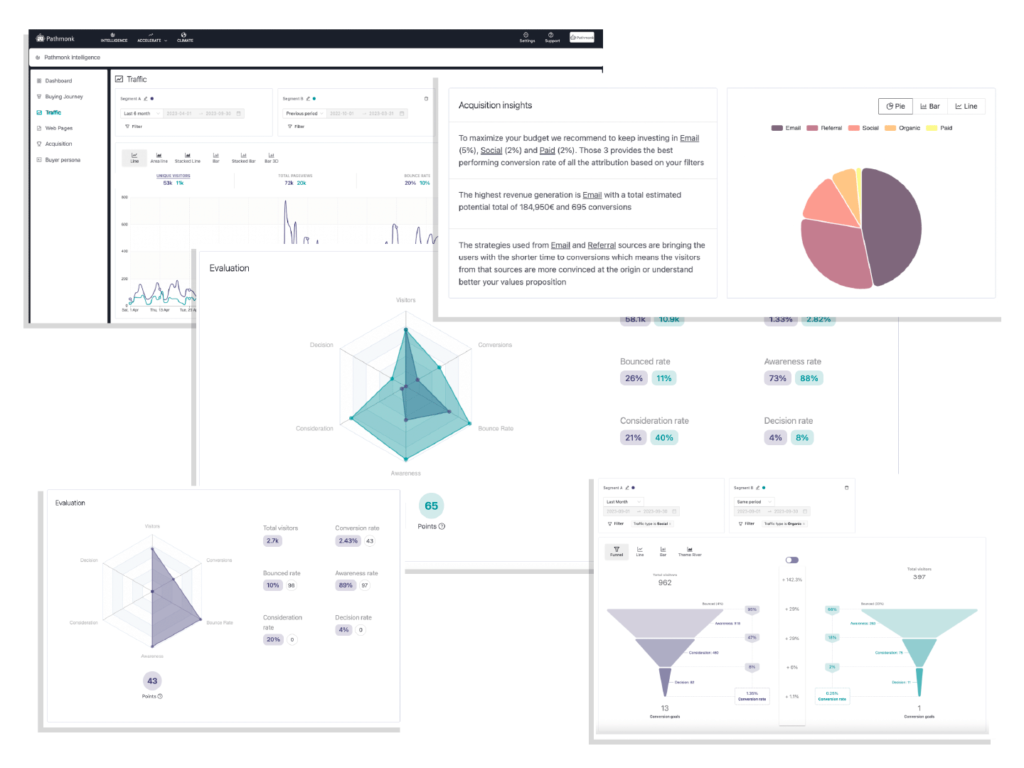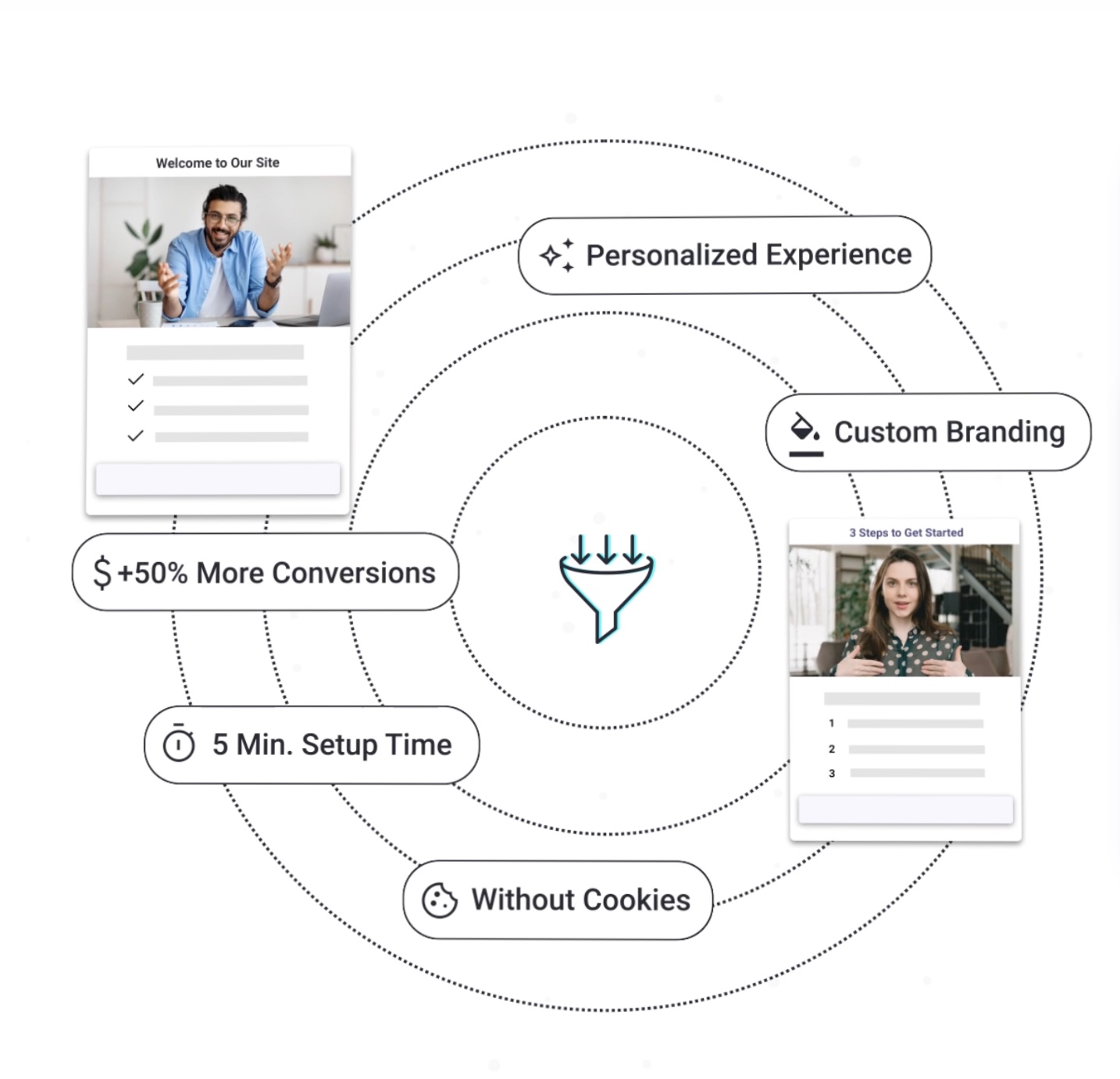How to Conduct a CRO Audit for Your Web: a Step by Step Guide


Conversion Rate Optimization (CRO) is often misunderstood as a process focused on conducting experiments and making changes. However, in reality, effective CRO is a data-driven discipline that requires deep research and analysis before embarking on any testing. In fact, CRO is 80% research and 20% experimentation.
The research phase of CRO is vital for understanding user behavior, identifying pain points, and uncovering optimization opportunities. By delving into data and user insights, marketers gain valuable knowledge about their audience, their preferences, and the factors influencing their decision-making process. This information serves as the bedrock for formulating effective optimization strategies that resonate with users and drive conversions.
In this comprehensive guide, we’ll walk you through the step-by-step process of conducting a CRO audit for your website. We will emphasize the crucial role of research and provide you with a practical CRO checklist to ensure no stone is left unturned. By following this guide, you will be equipped with the knowledge and tools to unlock the full potential of your website conversions.
1. Identify Primary Conversion Goals
To embark on a successful CRO audit, it is essential to start by clearly defining your conversion goals and establishing relevant metrics for tracking progress. Without a clear understanding of what you aim to achieve and how you will measure success, it becomes challenging to effectively optimize your website for conversions.
Begin by identifying the primary actions or goals you want visitors to take on your website. These goals can vary depending on your business objectives and the nature of your website. Common primary conversion goals include:
- Making a purchase
- Requesting a quote or consultation
- Signing up for a newsletter or subscription
- Completing a form submission
- Downloading a resource or accessing gated content
By clearly defining your primary conversion goals, you can focus your efforts on optimizing the specific actions that directly impact your business objectives.
2. Establish Relevant Metrics for Tracking Progress
Once you have identified your primary conversion goals, it is crucial to establish relevant metrics to track your progress and measure the effectiveness of your optimization efforts. These metrics will serve as key performance indicators (KPIs) and provide valuable insights into the success of your CRO initiatives.
Consider the following metrics that are commonly used in CRO:
- Conversion Rate: The percentage of visitors who complete the desired action or goal.
- Average Order Value: The average value of each transaction or purchase made.
- Click-through Rate (CTR): The percentage of visitors who click on a specific element, such as a CTA or a link.
- Bounce Rate: The percentage of visitors who leave the website after viewing only a single page.
- Time on Page: The average amount of time visitors spend on a particular page.
- Exit Rate: The percentage of visitors who leave the website after viewing a specific page.
Select metrics that align with your primary conversion goals and provide meaningful insights into user behavior and engagement. These metrics will serve as benchmarks for evaluating your website’s performance and identifying areas that require optimization.
3. Analyze Current Conversion Rates and Performance
Start by assessing your website’s current conversion rates and performance metrics. This involves examining key conversion indicators and evaluating how well your website is currently meeting your goals. Consider the following metrics:
- Overall Conversion Rate: Calculate the percentage of visitors who complete a desired action or goal on your website.
- Goal-Specific Conversion Rates: Analyze the conversion rates for individual goals or actions, such as purchases, form submissions, or newsletter sign-ups.
- Funnel Conversion Rates: Evaluate the conversion rates at various stages of your conversion funnel, from initial entry points to final conversions.
By analyzing these metrics, you can identify areas of strength and weakness in your current conversion performance. This understanding will guide your optimization efforts and help you prioritize areas that require immediate attention.
4. Collect User Behavior Data
To gain deeper insights into user behavior and preferences, it’s essential to collect user behavior data. This data provides valuable information about how users interact with your website, where they encounter friction or obstacles, and which elements attract their attention.
When conducting user testing, you have two main options for sourcing testers: using tools that offer a pool of testers or recruiting testers from your own network. The choice between these approaches depends on the nature of your website and target audience.
- Tools such as UserTesting and TryMyUI provide a convenient way to access a pool of testers who can evaluate your website. This option is most suitable for websites with a mass-market appeal, such as those selling clothing, shoes, toys, and similar products. These tools offer a streamlined process and quick access to a diverse group of testers who are seeing your site for the first time.
However, it’s important to note that these tools may not be ideal for websites targeting niche audiences, such as ophthalmologists, marketing professionals, or dog trainers. In such cases, it is recommended to explore alternative approaches for recruiting testers.
Recruiting Testers from Your Network: For websites with niche audiences or specialized industries, it is often more effective to recruit testers from your own network. This approach allows you to engage individuals who are familiar with your industry or have a specific interest in your niche. Consider reaching out to the following sources within your network:
- Blog Readers: Engage with your blog readers and invite them to participate in user testing sessions. Their familiarity with your content makes them valuable contributors.
- Newsletter Subscribers: Use your newsletter subscriber base by inviting them to take part in testing activities. They have already shown interest in your offerings and can provide valuable insights.
- Twitter Followers: Tap into your Twitter community and seek volunteers from your follower base. This approach helps you engage with individuals who are already interested in your brand.
- Friends of Friends: Leverage personal connections and extend your reach by asking friends to refer testers from their own networks. This approach allows you to access a wider range of participants.
- Ethnio and Similar Tools: Use tools like Ethnio to recruit testers directly from your website. This method enables you to target specific user segments and gather feedback from your actual website visitors.
How User Testing Differs from A/B Testing: Gaining Deeper Insights
A/B testing and user testing are two distinct methods used to gather insights and optimize website performance. While A/B testing focuses on comparing different versions of a webpage with real visitors and takes longer to get conclusive results, user testing involves observing recruited testers as they complete specific tasks on the website.
A/B testing is conducted on a live website, where variations of a webpage are presented to visitors without their knowledge. It provides valuable statistical data by comparing conversion rates and other metrics between the different versions. On the other hand, user testing usually takes place before the website goes live and can be done in person or remotely. Testers are observed while completing tasks, and their screen and voice are recorded to capture their thought processes and feedback.
The flexibility of user testing allows you to gather insights at any stage of the design process, even before the website is online, providing the opportunity for iterative improvements.
A/B testing requires a significant sample size, often involving hundreds or even thousands of participants to achieve statistically significant results. In contrast, user testing can be conducted with a smaller sample size of around 10 people or even fewer.
While A/B testing provides quantitative data and statistical confidence, user testing offers qualitative insights into the user experience, allowing for a deeper understanding of user behavior and preferences.
5. Understand Your Conversion Funnel and Check Your Drop-Offs
To conduct a thorough CRO audit, it is crucial to understand your conversion funnel and identify areas where visitors drop off or abandon the desired action. By examining the funnel and analyzing drop-off points, you can pinpoint critical areas for optimization.
Intuitive Cookieless Analytics for Your Web
Understand your customer journey, find drop-offs, and receive actionable insights with AI.

Begin by mapping out your conversion funnel, which represents the journey visitors take from the initial entry point to the ultimate conversion goal. Pathmonk Intelligence automatically identifies the key stages of the funnel, such as landing pages, product pages, shopping carts, and checkout processes. With Pathmonk Intelligence you can quickly understand the flow of traffic and the path visitors follow as they move through each stage.
Visualizing your conversion funnel allows you to identify potential bottlenecks and areas where visitors may experience friction or difficulties. This understanding serves as a foundation for optimizing each stage of the funnel.
Once you have mapped your conversion funnel, analyze the data to identify drop-off points – the stages where visitors leave the funnel without completing the desired action. This could include scenarios where visitors abandon their cart, exit during the checkout process, or fail to submit a form.
Use analytics tools to track the conversion rates and behavior of visitors at each stage of the funnel. Look for significant drop-offs or areas with lower conversion rates. These are the critical points where optimization efforts can have a substantial impact on your overall conversion rate.
Dig deeper to understand the potential causes of drop-offs at each stage. Examine factors that could contribute to visitor hesitation or abandonment, such as:
- Confusing navigation
- Complex messages, lack of storytelling
- Lengthy and cumbersome forms
- Intrusive popups
- Lack of trust signals or social proof
- Slow page load times
- Insufficient product information or unclear value proposition
By identifying the specific causes of drop-offs, you can formulate targeted strategies to address those issues and improve the user experience.
6. Review Our CRO Audit Checklist
- Search functionality: Is the search bar easy to find and use? Does it return relevant results?
- Forms: Are any forms on the website easy to use and fill out? Are there any fields that are causing issues?
- Mobile optimization: Is the website optimized for mobile devices? Are buttons and links easy to click on a smaller screen?
- User flows: Can visitors easily navigate through the website to complete desired actions – like making a purchase or filling out a form?
- Page load speed: Is the website loading quickly across all devices? Are there any slow-loading pages that need optimization?
- Call-to-action (CTA) placement: Are CTAs strategically placed throughout the website? Are they easily distinguishable and enticing?
- Visual hierarchy: Does the website use a clear visual hierarchy to guide users’ attention and prioritize important content?
- Error handling: How are errors communicated to users? Are error messages clear, specific, and helpful in guiding users toward resolution?
- Trust signals: Are trust elements, such as security badges, customer testimonials, or third-party certifications, prominently displayed?
- Accessibility: Does the website comply with accessibility guidelines? Are there any barriers for users with disabilities?
- Content relevancy: Is the content on the website relevant and aligned with users’ expectations and needs?
- Social media integration: Are social media sharing buttons available and functioning properly?
- Browser compatibility: Is the website compatible with different browsers and their various versions?
- Image optimization: Are images optimized for faster loading times without compromising quality?
- Cross-device consistency: Is the user experience consistent across different devices and screen sizes?
- Payment options: Are there multiple payment options available? Is the checkout process secure and trustworthy?
- Personalization: Does the website offer personalized experiences based on user preferences or previous interactions?
- Exit intent strategies: Are exit pop-ups or offers implemented to engage users who are about to leave the website?
- Content readability: Is the website’s content easy to read, with appropriate font sizes, line spacing, and contrast?

- Social proof elements: Are there social proof elements, such as reviews, ratings, or case studies, to build trust and credibility?
- SEO optimization: Is the website optimized for search engines? Are relevant keywords incorporated into page titles, headings, and content?
- Conversion tracking setup: Is conversion tracking properly set up to measure key performance indicators and analyze user behavior?
- Multilingual support: Does the website support multiple languages to cater to a diverse user base?
- Pricing transparency: Is pricing information clear and transparent? Are there any hidden costs or fees that may deter users?
- Testimonials and reviews: Are customer testimonials and reviews prominently displayed to build trust and credibility?
- Cross-browser testing: Has the website been tested for compatibility across different web browsers, including popular ones like Chrome, Firefox, Safari, and Edge?
- Broken links: Are there any broken or dead links on the website? Are internal and external links functioning properly?
- Usability on different devices: Does the website provide a seamless user experience across various devices, including desktops, laptops, tablets, and smartphones?
- Video content optimization: Are videos properly optimized for faster loading times? Are they easily accessible and playable on different devices?
- Privacy policy and data protection: Is there a privacy policy in place that clearly communicates how user data is collected, stored, and protected?
- Blog optimization: Is the blog section regularly updated with relevant and high-quality content? Are there clear calls to action within blog posts?
- Personal data collection: Are there any unnecessary data collection points or forms that may deter users from completing actions?
- URL structure and permalinks: Is the URL structure clean, concise, and optimized for search engines? Are permalinks descriptive and user-friendly?
- Cross-selling and upselling opportunities: Are there opportunities to cross-sell or upsell products/services during the user journey? Are they effectively utilized?
- Customer support options: Is customer support easily accessible? Are live chat, email, or phone support options available to address user queries?
- 404 error page: Does the website have a customized 404 error page that helps users navigate back to the desired content or take alternative actions?
- Third-party integrations: Are third-party integrations (e.g., payment gateways, analytics tools, CRM systems) functioning correctly and providing accurate data?
- Newsletter subscription: Is there an option for users to subscribe to newsletters or updates? Is the subscription process easy and clearly communicated?
- Geo-targeting and localization: Does the website cater to users from different regions or languages? Is there a mechanism to serve localized content?
7. Optimize Problematic Areas on Landing Pages for Conversion
With a clear understanding of your CRO audit and the previous research, prioritize the areas that require optimization. Develop strategies to overcome the challenges and improve the user experience at each stage. As you have seen, this may involve simplifying forms, streamlining the checkout process, enhancing product descriptions, or addressing any other specific issues identified.
Use Pathmonk Accelerate for an Immediate Lift in Your Conversion Rate
Pathmonk Accelerate is an industry-leading conversion rate optimization (CRO) tool designed to drive immediate and significant improvements in your website’s conversion rates. With its cutting-edge features and user-friendly interface, Pathmonk Accelerate empowers you to optimize your website for maximum conversions.
More Sales From Your Website With AI
Personalized interactions based on your users' behaviour to get +50% more conversions.

Here’s how Pathmonk Accelerate can help you boost your conversion rate:
- Personalized Experiences: Leverage the power of AI-driven algorithms to receive personalized interactions based on user intent tailored to your specific website. This has proven to increase conversions by +50% on average.
- Behavior Analytics: Gain deep insights into your visitors’ behavior with Pathmonk’s comprehensive behavior analytics. Track user interactions, engagement patterns, and conversion funnels to understand how users navigate your website and uncover opportunities for optimization. With Pathmonk you can also identify hotspots, user engagement areas, and potential bottlenecks to optimize your website’s layout, design, and user flow for enhanced conversions.
- Personalized A/B Testing and Experimentation: Conduct A/B tests effortlessly with Pathmonk Accelerate’s powerful testing capabilities. Test different variations of key elements, such as headlines, call-to-action buttons, or page layouts, and measure their impact on conversion rates. Optimize your website based on data-driven insights to continuously improve your conversion performance.
- Exit Intent Technology: Engage and retain visitors who are about to leave your website with Pathmonk Accelerate’s exit intent technology. Display targeted messages, offers, or incentives at the right moment to re-engage users and increase your chances of conversion.
- Seamless Integration: Pathmonk Accelerate seamlessly integrates with popular CMS platforms and e-commerce systems, making it easy to implement and start optimizing your website quickly.
Implement a Data-Driven Culture of Constant Monitoring and Optimization
To achieve continuous improvement in your conversion rate, it’s crucial to foster a data-driven culture of constant monitoring and optimization. By embracing data and making it a core part of your decision-making process, you can unlock valuable insights and drive impactful changes.
Some things to consider when formulating your data-driven approach:
- Define clear and measurable Key Performance Indicators (KPIs)
- Set up analytics tools such as Pathmonk Intelligence to gather comprehensive data on user behavior.
- Conduct testing to experiment with different website variations and messages.
- Gather user feedback through surveys and feedback forms.
- Continuously optimize based on data analysis and user feedback.
- Invest in training and education for your team members.
Conduct regular performance reviews to evaluate optimization efforts.
Conclusion
By conducting a CRO audit and implementing data-driven strategies, you can improve website conversions and drive business growth. This step-by-step guide has provided valuable insights and practical tips for conducting a comprehensive CRO audit. From defining goals and metrics to optimizing problematic areas, each stage of the audit process contributes to uncovering optimization opportunities and enhancing the user experience.
By leveraging tools and techniques such as user testing, data analysis, A/B testing, and behavior analytics, you can make informed decisions that lead to higher conversion rates and improved website performance. It is essential to embrace a data-driven culture of constant monitoring and optimization, continuously seeking ways to enhance user experience and drive conversions. By adopting these practices, stay ahead of the curve and maximize the potential of your website.





